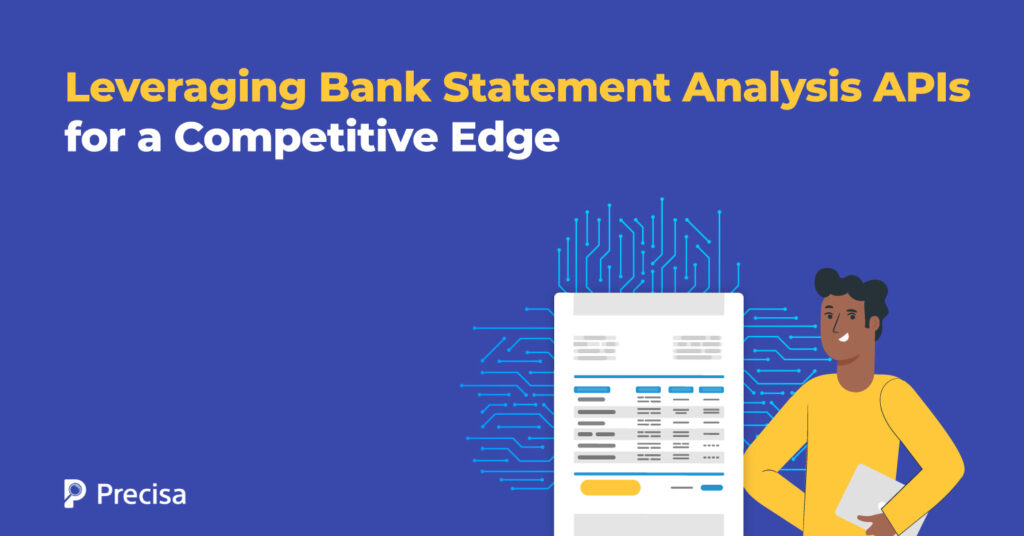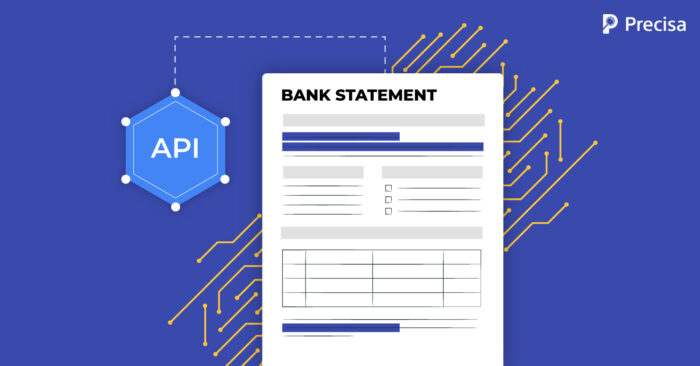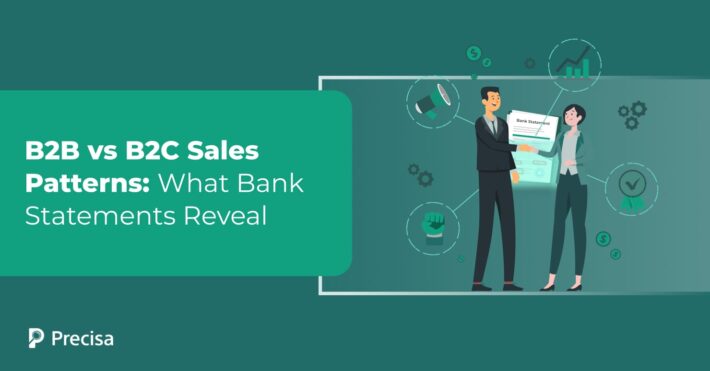Bank Statement Analysis APIs for a Competitive Edge

Due to several factors, lenders are now more likely than ever to make poor risk assessment decisions. These include the speed at which lenders aim to approve loan applications, the growing potential for loan fraud, and increasing delinquent debt.
Also, unexpected market downturns and opportunity costs contribute to the risk factors. Moreover, as lenders scale, the risks get even higher.
One of the most effective ways to tackle these challenges is to use technology smartly. For example, early investments in a superior bank statement analysis API can help lenders strengthen their risk assessment and fraud detection capabilities, which in turn can lead to superior underwriting decisions.
In this blog post, we explore the transformative potential of bank statement analysis tools for lenders and their impact on optimising revenue growth.
What is a Bank Statement Analysis API?
The growth of digital lending culture, access to digital statements, and increase in risk factors are nudging lenders to use cutting-edge technology to do the work.
A bank statement analysis API is an interface that enables businesses to evaluate a customer’s cash flows, behaviours, and financial creditworthiness efficiently, speedily, and accurately.
Bank statement analysis tool leverages the combined benefits of technologies, such as Artificial Intelligence (AI), Machine Learning (ML), Robotic Automation, Optical Character Recognition (OCR), cloud computing, and Python.
With these capabilities, lenders can make more comprehensive data-driven decisions rather than relying on traditional metrics such as credit scores, salary slips, and revenue statements.
Also, the early adoption of automated bank statement analysis allows lenders to review a customer’s finances in more detail.
7 Advantages of Bank Statement Analysis API

Here are seven ways a bank statement analysis API can help lenders make data-driven decisions:
Higher Efficiency and Accuracy
The adoption of a bank statement analysis API helps lenders completely automate the end-to-end financial analysis process. When a borrower applies for a loan, they need to submit several documents.
For instance, they may submit identity-related documents such as an Aadhaar card, PAN card, and bank documents as part of the loan application.
Tools such as Precisa API completely automate document identification, data extraction, and financial analysis. The software can also recognise over 700 types of documents.
As automation replaces manual interventions, data is processed quickly and efficiently. With Precisa, processing speed increases by 5X, while the prospect of errors, duplication, and data omissions is eliminated.
Predictive Analysis and Insights
Today, multiple factors determine a borrower’s financial health. These include credit history, assets, liabilities, financial behaviours and patterns, and cash flows. Using a bank statements analysis API enables lenders to host all information in one location.
Lenders can customise dashboards to get a 360° view of the numbers. This is a more comprehensive approach rather than viewing isolated information that does not tell a borrower’s complete story.
Alternatively, they can look at specific metrics such as EMI payment patterns, penalties on bounced checks, or revenues.
Thus, they can understand a customer’s past behaviours and patterns to predict whether they can pay back a loan in the future. Lenders can also leverage in-depth data insights to understand borrower trends and predict business opportunities in the future.
Superior Risk Assessment
This is one of the most important functions for a lender, where accuracy is a key challenge. Accounting for every financial transaction is an important part of this process.
A bank statement analysis tool segregates every transaction into inflow and outflow categories. The tool further segregates these two categories into sub-categories.
For example, revenues, interest, capital gains, and tax refunds are sub-categorised under inflows, and employee salaries, EMIs, and vendor payments are sub-categorised under outflows.
Fraud Detection Capabilities
The use of AI enables the bank statement analysis API to detect unusual patterns in bank transactions such as circular transactions.
Going further, the software can recognise minute discrepancies in documents, which can flag potential fake documentation. The software can also quickly scan through large volumes of data to flag cases of identity theft.
By enabling these three functionalities, lenders can considerably reduce the potential for being embroiled in loan fraud. This is a valuable safeguard to help avoid negative consequences such as investigation by regulatory bodies, a negative impact on public reputation and a drop in share prices. Business shutdowns are another potential outcome.
Reduce Opportunity Costs
Today, ambitious lenders are racing to fill the credit gaps in the market. For instance, lenders are vying to serve Micro, Small And Medium Enterprises (MSMEs) and underserved individual borrowers more effectively. However, existing loan products may prove too expensive.
A superior bank statement analysis API can deliver customised solutions based on real-time financial data and the borrower’s needs. Typically, these solutions prove more cost-effective to the borrower and thus expedite conversions.
This functionality gives lenders an edge by empowering them to make data-driven decisions and serve underserved borrowers quickly and efficiently.
GSTR Cross-Analysis
Another unique and useful capability of the bank statement analysis API is its Goods & Service Tax Returns (GSRT) cross-analysis capabilities. This automated process allows lenders to cross-check revenue-based bank transactions against the respective GSTR information.
This process helps lenders examine cash flows more effectively. First-time borrowers with no assets can especially benefit from demonstrating their real-time business cash flows.
Ease of Integration
An advantage of the API is that lenders can easily integrate it into their existing financial management platforms. They do not need to make a complete shift, which consumes time and resources, not to mention disrupts the workflow.
Due to its user-friendly features, teams can enjoy a smooth transition to using the tool. Lenders do not need to invest resources and time in extensive training.
With access to such a tool, team members can be engaged in more strategic tasks. Lenders can function with lean teams and bring down human capital costs.
The Takeaway
The lending landscape is getting more competitive today. Bbanks, digital platforms, Non-Banking Financial Companies (NBFCs), and payment apps are all vying for similar audiences.
Lenders embracing superior technology can build a competitive edge and capture greater market share. Early adoption of a cutting-edge, easy-to-integrate bank statement analysis API can help lenders grow their businesses efficiently and quickly.
Presica’s comprehensive and seamless financial data analysis solution simplifies and speeds up the process through automation. The software provides actionable insights on a customisable dashboard, thus helping companies make informed business decisions.
Request a free demo today!



